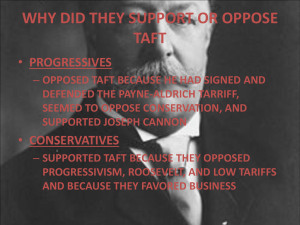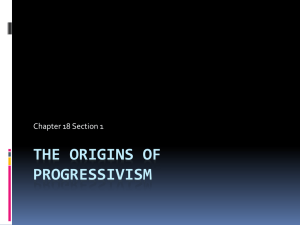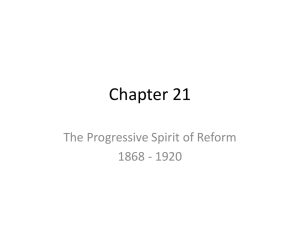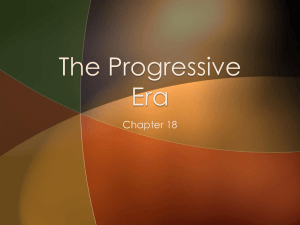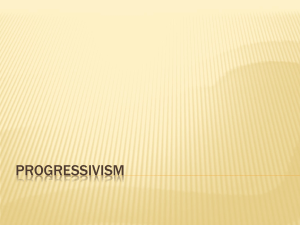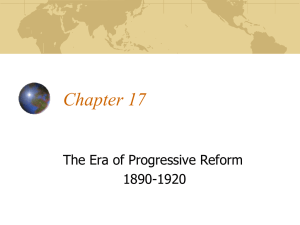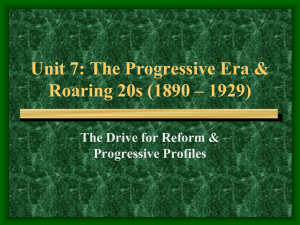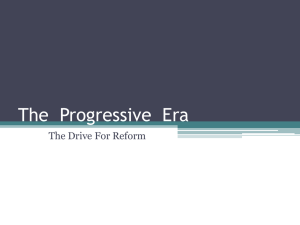Chapter 20 Lecture PowerPoint
advertisement
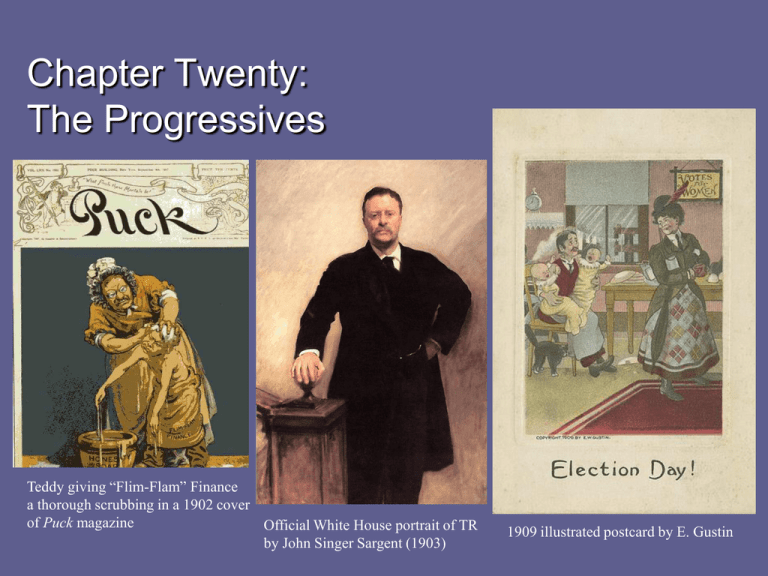
Chapter Twenty: The Progressives Teddy giving “Flim-Flam” Finance a thorough scrubbing in a 1902 cover of Puck magazine Official White House portrait of TR by John Singer Sargent (1903) 1909 illustrated postcard by E. Gustin Chapter Twenty: The Progressives The Progressive Impulse Desire for Order: Many Americans in the late 19th and early 20th century felt that rapid industrialization and urbanization had created too much chaos and social instability. Growth of Progressivism: Started with local movements that grew to national efforts; ultimately it was the presidency rather than Congress that became the chief vehicle of reform. Belief in Progress: Progressives wanted progress and growth, but not in the the uncontrolled, laissez-faire style of Gilded Age; direct and forceful human intervention was required for bettering society. “Antimonopoly”: While the progressive impulse was diverse, one strong thread was the desire to break up and limit large concentrations of wealth and power. Faith in Knowledge: Progressives thought they could solve tough social problems by applying knowledge and expertise. 2 Chapter Twenty: The Progressives The Progressive Impulse – The Muckrakers and the Social Gospel Crusading Journalists: Reporters looking to uncover social, economic, and political injustice who Teddy Roosevelt chastised for “raking up muck” were the first to embody the national reform spirit. Charles Francis Adams Jr. (1835-1915): This early “muckraker” and member of the prominent Massachusetts family exposed the ruthless practices of financiers Jay Gould and James Fisk as they tried to gain control over the Erie Railroad in 1868. Ida Tarbell (1857-1944): She wrote a series of exposés on the ruthless business practices of John D. Rockefeller and Standard Oil in McClure’s Magazine in 1903, which was published as a book a year later. Lincoln Steffens (1866-1936): Steffens wrote a series of exposés on corruption in city governments also in McClure’s, which he later published as The Shame of the Cities (1904). Tarbell and Steffens would later leave McClure’s to form The American Magazine (1906). 3 Chapter Twenty: The Progressives The Progressive Impulse – The Muckrakers and the Social Gospel The Social Gospel: This broad label applies to various efforts to drive social reform through religion (namely Protestant Christianity). Though founded in England in 1865, the Salvation Army was typical of this idea, offering spiritual and material aid to the poor in most American cities by 1900. Charles Sheldon’s In His Steps (1898), a novel about a Protestant minister who leaves a cushy job for a tough urban environment, sold 15 million copies. The Social Gospel was not the predominant strand in Progressivism, but it was influential. Lincoln Steffens 4 Salvation Army Band in Brooklyn in 1909 Ida Tarbell Chapter Twenty: The Progressives The Progressive Impulse – The Settlement House Movement Influence of Environment: Many progressive urban reformers believed that crowded immigrant slums harmed individual development. “Settlement Houses”: The idea of having middle-class “settlement workers” come in and work with the urban poor originated in England, with Toynbee Hall opened in 1884 in East London. Jane Addams and Hull-House: The social reformer Jane Addams (18601935) opened the first U.S. settlement house, Hull-House, with Ellen Gates Starr (1859-1940) in the slums of Chicago’s Near West Side neighborhood. The house began the model for 400 other similar institutions across the United States. The settlement houses gave birth to the modern profession of social work, and were viewed as respectable places for unmarried college women to go and work. Addams was the first American woman to receive the Nobel Peace Prize in 1931. 5 Chapter Twenty: The Progressives The Progressive Impulse – The Settlement House Movement Jane Addams A Hull-House worker greeting local residents at the front door of Hull-House. 6 Exterior of the Hull-House complex, which had thirteen buildings by 1911. Chapter Twenty: The Progressives The Progressive Impulse – The Allure of Expertise Expertise and University Training: In general, Progressives placed a high value on “scientific” solutions to social problems, applying academic research and training to them. Thorstein Veblen (1857-1929): This Norwegian-American economist and sociologist imagined a society governed by expert “social engineers”; followers would later call this rule by “technocrats.” – The Professions “New Middle Class”: Historians give this label this new group of highly trained professionals who emerged around the turn of the twentieth century: managers, technicians, accountants, specialized lawyers and businessmen, and scientists and engineers. Professional organizations began to develop that set standards for training. 7 Chapter Twenty: The Progressives The Progressive Impulse – The Professions 8 American Medical Association: Founded as a loose organization in 1847, the association incorporated in 1897 and reorganized in 1901 to uphold strict scientific standards for those allowed to practice medicine, fighting against “quackery” that had long plagued American medicine. States began passing medical licensing laws, and medical education improved, especially as rigorous medical schools like Johns Hopkins (1893) were created, making U.S. medical education quickly on par with that of Europe. Legal Profession: By 1916, lawyers had established bar associations in all 48 states and law schools expanded to meet the demands. Business: Businessmen began funding schools of business administration, like the Wharton School at U. Penn (1881, and creating professional organizations like National Association of Manufacturers (1895) and the U.S. Chamber of Commerce, which became powerful lobbying tools. Exclusion: Professional organizations often excluded women and people of color. Chapter Twenty: The Progressives The Progressive Impulse – Women and the Professions Limited Opportunities: Even middle-class, college-educated women found their opportunities limited in the professions, although a small group became the first wave of female doctors, lawyers, engineers, scientists, and corporate managers. “Gender-Appropriate” Professions: Most gravitated toward professions that were considered suitable for women, like nursing, social work, and to the largest extent, teaching. In the late nineteenth century, 90 percent of of all female professionals were teachers. Some women also found careers in academia, teaching at new women’s schools. 9 Chapter Twenty: The Progressives Women and Reform Key Role of Women in Reform Causes: Women were leaders in progressive reform, but held few public offices, had only small footholds in most professions, and often shared the belief with middle-class men that women were not suited for the public world. – The “New Woman” 10 More Time: Middle-class housewives were having less children and kids were going to school at an earlier age. Shunning Marriage: Some college-educated women shunned marriage entirely to devote their lives to their careers. “Boston Marriages”: Some single women lived together with another woman in long-term relationships that were secretly romantic; such arrangements became marginally acceptable. Divorce Rates Rise: Divorce rates rose from one in twenty-one in 1880 to one in nine in 1920. Chapter Twenty: The Progressives Women and Reform – The Clubwomen 11 Women’s Clubs: These became more acceptable public spaces for middle-class and elite women in the late nineteenth century, largely as places for intellectual and cultural stimulation. General Federation of Women’s Clubs: Founded in 1892 to coordinate the activities of local clubs, it started with 100,000 members and 500 clubs. It reached one million members by 1917. Clubs and Social Reform: The women’s clubs evolved from primarily cultural institutions to advocates for social reform: labor laws for children and women, food and drug regulation, urban housing standards, anti-alcohol legislation, and also “mothers’ pensions” at the state level for abandoned or widowed mothers of young children. Chapter Twenty: The Progressives – The Clubwomen Clubs and Social Reform: The women’s clubs evolved from primarily cultural institutions to advocates for social reform: labor laws for children and women, food and drug regulation, urban housing standards, anti-alcohol legislation, and also “mothers’ pensions” at the state level for abandoned or widowed mothers of young children. Women’s Trade Union League: Founded in 1903 to by women union members and elite women to encourage women’s union membership, support strikers, and lobby for protective legislation. Black Women: Black women generally were excluded from white clubs, so they formed their own and also created an alternate umbrella organization: the National Association of Colored Women (created when two separate organizations merged in 1896). Overall: Clubs in general did not challenge the male-dominated order, but did provide a new kind of public space for women. 12 Chapter Twenty: The Progressives Women and Reform – Woman Suffrage Radical Challenge of Woman Suffrage: The idea that women had the same “natural rights” as men challenged the traditional idea that there should be a separate “sphere” for women, and that the “natural order” dictated women to stay home with children. Anti-suffrage activists claimed suffrage would lead to more divorce, promiscuity, and neglect of children. National American Woman Suffrage Association (NAWSA): Founded in 1890, this organization made big gains after the turn of the century. It went from 13,000 members in 1893 to over 2 million in 1917. Became the League of Women Voters after 1920. Argument for Suffrage: Suffrage would not challenge the separate sphere dynamic, but women would curb the belligerence of men and make war a thing of the past. 13 Chapter Twenty: The Progressives Women and Reform – Woman Suffrage: States 1890: Wyoming admitted to the Union permitting woman suffrage. 1893: Colorado adopts woman suffrage. 1896: Utah joins the Union permitting woman suffrage. 1910: Washington State adopts it. 1912: Oregon, Kansas, and Arizona adopt woman suffrage. 1914: Nevada and Montana adopt woman suffrage. 1917: New York women are granted suffrage. 1918: Michigan, South Dakota, and Oklahoma adopt woman suffrage. 1919: Thirty-nine states adopt suffrage for women in at least some elections. 14 Chapter Twenty: The Progressives Suffragette Parade in NYC, 1915 15 Chapter Twenty: The Progressives Women and Reform Alice Paul – Woman Suffrage Nineteenth Amendment: Finally passes in 1919 is ratified on August 18, 1920. Susan B. Anthony and Elizabeth Cady Stanton had drafted the amendment in 1878, and it became law over four decades later. It failed to pass the House in 1915; it passed the House but not the Senate in 1918, and then narrowly failed again in February 1919. President Wilson called for a special session in May and June to get it done, and it at last passed with considerable pressure from him. Equal Rights Amendment: Feminist Alice Paul (1885-1977) broke away from NAWSA in 1916, frustrated with its “separate sphere” argument. She believed that women needed not just suffrage, but also laws protecting their rights and preventing discrimination. Paul’s proposals were mostly ignored. 16 Chapter Twenty: The Progressives The Assault on the Parties Reforming Government: Progressives argued that government needed to be reformed before society at large could be, and that the two major parties were obstacles to making government an instrument for change. Two-Party Stranglehold: From the 1870s to the 1890s, the Greenback Party and the Populists tried to break the big party stranglehold, as did the independent Republican reformers known as the Mugwumps. Some Reforms: For example, most states in the 1880s and 1890s adopted the secret ballot, which weakened party power. Before the secret ballot, parties printed the “tickets” and often hard party thugs observe voting behavior. 17 Chapter Twenty: The Progressives The Assault on the Parties – Municipal Reform Urban Reform: Most Progressives saw city governments as the most corrupt and incompetent aspect of party politics, and thus were targeted by muckraking journalists like Lincoln Steffens. Motivated middle-class urbanites took up the fight against the bosses. Commissions and City-Managers: In Galveston, Texas, after a devastating flood in 1900 and a poor city government response, voters replaced the mayor with an elected nonpartisan commission. The model of a nonpartisan commission or a city manager grew across the country, with 400 cities being governed by commission and 45 being governed by a city manager by the end of the Progressive Era. City managers were trained engineers or administrators. 18 Chapter Twenty: The Progressives The Assault on the Parties – Statehouse Progressivism Boss-Controlled State Legislatures: Reformers looked for ways to circumvent what they saw as corrupt and incompetent bodies. Initiative or Proposition: This ballot mechanism submits legislation directly to the voters for approval. Referendum: Actions of the legislature can be returned to the voters for their approval. Twenty states had either initiative or referendum laws by 1918. Direct Primary and Recall: The direct primary removes the power of choosing candidates from the party bosses, giving it to the people. Recalls could get an official removed through a special election that could be held if enough signatures were collected. All states adopted the primaries by 1915, but only a few (like California) adopted the recall. 19 Chapter Twenty: The Progressives The Assault on the Parties – Robert La Follette (1855-1925) Progressive Governor: Elected governor of Wisconsin 1900, La Follette made the state into “a laboratory of progressivism”: created a workers’ compensation system, railroad rate reforms, a primary system, a minimum wage, nonpartisan elections, and a close relationship between state officials and academics at the University of Wisconsin who together tried to solve social problems. – Parties and Interest Groups Decline in Party Influence: The reformers lessened party influence, but also contributed to a decline in voter turnout: 73 percent of the electorate voted in 1900, but only 59 percent in 1912. It would never go over 70 percent again (In 2004 and 2008, voter-age turnout was 56.69 and 57.37.) “Interest Groups”: Professional organizations, trade groups, labor unions, and farm lobbies replaced some aspects of party influence. 20 Chapter Twenty: The Progressives Sources of Progressive Reform – Labor, the Machine, and Reform Varied Progressive Groups: Middle-class reformers from the East were the most visible face of the Progressive movement, but working-class Americans, African Americans, westerners, and even party bosses took part in reform. Labor: Although the AFL led by Samuel Gompers remained mostly aloof from reform, some unions did become powerful advocates for regulatory legislation: between 1911 and 1913, the Union Labor Party in California exerted pressure that led to passage of a child labor law, workmen’s compensation, and limitations on women’s working hours. 21 Chapter Twenty: The Progressives Shirtwaist Sources of Progressive Reform – Labor, the Machine, and Reform C.F. Murphy 22 Reform from within Tammany: The astute boss of Tammany Hall, Charles Francis Murphy, began to align some of its policies with the reformers’ agendas that did not offend its constituency, like cleaning up the police department and curbing prostitution. Triangle Shirtwaist Fire: In 1911, a horrific fire in the top floor of the Triangle Shirtwaist Company trapped workers— mostly immigrant women—in the top floors of a factory building. Within 18 minutes, 146 were killed, largely because emergency exits had been locked. Tammany Democrat legislators Robert Wagner and Alfred Smith led the charge to create a series of new laws that imposed strict regulations on factory owners with effective enforcement mechanisms. Chapter Twenty: The Progressives Four victims of the Triangle Fire: Max Florin, Fannie Rosen, Dora Evans and Josephine Cammarata Bodies of three women who had fallen to their deaths 23 Chapter Twenty: The Progressives Sources of Progressive Reform – Western Progressives Importance of the Federal Government: Out in the Far West, federal authority was much greater than in the East since many important issues, like water sources that flowed across state lines and major subsidies in the form of land grants or funds for railroad and water projects. Reformers thus targeted the federal government more. Progressive Western Congressmen: Progressive Republican George Norris (1861-1944) of Nebraska, for example, supported the direct election of senators, advocated for the rights of labor, and was an antiwar isolationist. 24 Chapter Twenty: The Progressives Sources of Progressive Reform – African Americans and Reform White Progressives: The issue of racial justice, with just a few exceptions, was not on the white progressive agenda. Some were what we now consider to be overtly racist now. Booker T. Washington (1856-1915): The founder of the Tuskegee Institute did not encourage long-term social reform and challenging the social order, but favored African Americans focusing on selfimprovement. In 1901, Roosevelt invited him to dine at the White House. W.E.B. Du Bois (1868-1963): Du Bois, a Harvard-trained sociologist and historian, challenged Washington’s stance. In his 1903 Souls of Black Folk, he attacked Washington for encouraging white efforts to segregate and keep black aspirations limited. Talented blacks needed full liberal educations, should aspire to professional careers, and struggle for their civil rights and not sit passively waiting for them. 25 Chapter Twenty: The Progressives “Is it possible and probable that nine millions of men can make effective progress in economic lines if they are deprived of political rights, made a servile caste, and allowed only the most meager chance for developing their exceptional men?” W. E. B. Du Bois The Souls of Black Folk (1903) 26 Chapter Twenty: The Progressives Sources of Progressive Reform – African Americans and Reform Founding of the NAACP: In 1905, Du Bois and a group of his supporters met on the Canadian side of Niagara Falls since no hotels on the New York side would have them. In 1909, this group—along with some sympathetic white supporters—created the National Association for the Advancement of Colored People (NAACP). Focus on Legal Rights and Anti-Lynching: The NAACP focused its efforts on equal legal rights and trying to get anti-lynching laws passed. Ida B. Wells-Barnett (1862-1931): One of the most fearless anti-lynching crusaders was this journalist and political activist employing extensive data and sophisticated analysis in her writings. 27 Chapter Twenty: The Progressives Crusades for Social Order and Reform – Morality and Social Order Legislating Morality: While progressive spent a lot of energy reforming politics, many also sought to “legislate morality”: pass laws prohibiting alcohol, curbing prostitution, limiting divorce, and preventing too great a influx of immigrants. White Protestant “Norms”: Many progressives were white middle-class or upper-class Protestants who sought to impose their own sense of morality on the rest of society since they viewed themselves as “true Americans,” and that immigrants and African Americans, for example, needed to assimilate to their ways. During the progressive era, states often enforced “blue laws” against the sale of alcohol or playing baseball on Sunday, which angered immigrant groups who liked to use Sunday as a day of leisure. 28 Chapter Twenty: The Progressives Crusades for Social Order and Reform – The Temperance Crusade Frances Willard 29 Crusade against Alcohol: Many progressives saw banning the sale as alcohol as necessary to restore social order as it was a major contributing factor in domestic violence among working-class families. Some employers were also in favor of these measures since alcohol could have a negatives effect on efficiency and absenteeism. Saloons also tended to be important organizing points for urban political machines like Tammany. WCTU: Formed in 1873, the Women’s Christian Temperance Union was led as of 1879 by a forceful spokesperson, Frances Willard (1839-1898). It merged with the Anti-Saloon League in 1893, and had 245,000 members by 1911, making it the largest women’s organization in the U.S. Eighteenth Amendment: By 1916, the WCTU had managed to get 19 states to pass prohibition laws. In 1917, progressives, joined by rural Christian fundamentalists, got amendment passed in Congress. It was ratified over the next two years, going into effect in January 1920. Chapter Twenty: The Progressives Crusades for Social Order and Reform – Immigration Restriction Immigrants as a Source of Disorder: Many progressives saw immigrants as a major source of social disorder in the cities. Some progressives thought it best to help them assimilate, while others thought that the flow—peaking in 1907 with 1,285,349—needed to be restricted. Eugenics: Many popular quasi-scientific theories around 1900—called “eugenics”—posited that immigrants from Eastern and Southern Europe were of inferior racial stock, and that letting so many in would lead to inevitable mixing with superior Northern European ethnicities, leading to a dilution of the Anglo-Saxon majority. Dillingham Commission: This special joint congressional committee led by Senator William P. Dillingham of Vermont met to investigate immigration in 1907. It implied that the recent immigrants were less assimilable than earlier waves, and that restrictions should be placed on those Southern and Eastern European nationalities. Big business interests helped to prevent this legislation from passing since they wanted the cheap labor source. 30 Chapter Twenty: The Progressives Crusades for Social Order and Reform – The Dream of Socialism Socialism’s Peak: The period between 1900 and 1914 was the period of peak interest in the U.S. In the 1900 presidential election, it carried only 100,000 voters, but hit 1 million in 1912. Eugene V. Debs (1855-1926): He was the Socialist Party candidate for president in 1900, 1904, 1908, 1912, and 1920, the last time from a prison cell. He received his most votes in 1912. His leadership of the American Railroad Union during the Pullman Strike converted him to socialism. “Wobblies”: The Socialist Party believed in taking power through electoral politics, but more radical groups believed in militant direct action and violence. One such group was the International Workers of the World, founded in Chicago in 1905, led by William “Big Bill” Haywood (18691928). The IWW was the only union that was concerned with unskilled workers—wanting to bring all workers into the same union—and were also believed to have dynamited railroads and power stations. 31 Chapter Twenty: The Progressives Crusades for Social Order and Reform – The Dream of Socialism Socialism’s Demise: The socialist refusal to support the war effort when the U.S. entered World War I and the crackdown on radicals and the First Red Scare (1919-1921) after the war did much to kill off most of the popular support the Socialist Party enjoyed. “Big Bill” Haywood of the IWW 32 Eugene V. Debs of the Socialist Party Chapter Twenty: The Progressives Crusades for Social Order and Reform – Decentralization and Regulation Reforming Capitalism: Most progressives wanted to make reforms within capitalism itself rather than institute a whole new economic system. Louis D. Brandeis (1856-1931): This brilliant lawyer from Kentucky wrote a book, Other People’s Money and How the Bankers Use It (1914), argued against investment bankers using middle-class people’s investments to consolidate big corporations, which was in their own interests, but not in those of small investors. Brandeis argued that the federal government should prevent all big combinations from happening. In 1916, President Wilson nominated him to the Supreme Court, and he became the first Jewish person to serve in that capacity. “Good Trusts” and “Bad Trusts”: Other progressives thought that big corporations were unavoidable, but they needed to be strongly regulated by the federal government. This was the attitude of Theodore Roosevelt. 33 Chapter Twenty: The Progressives Theodore Roosevelt and the Modern Presidency – The Accidental President 34 Iconic President: Theodore Roosevelt (1858-1919) became an iconic figure not so much for his reform agenda, but for expanding the powers of the presidency and making the office the center of national political discourse— in essence, making it what it is today. President by Accident: When McKinley was assassinated in September 1901, Roosevelt became the youngest president to take the office, at age 42. The Republican establishment had deep regrets about having put this “wild man” on the ticket. Roosevelt’s Vision of Federal Power: He believed the federal government should regulate, not destroy the trusts. Northern Securities Company: In 1902, Roosevelt had the Justice Department pursue an anti-trust suit against this gigantic railroad trust that eliminated competition between several important Western railroads. It was one of the first uses of the Sherman Anti-Trust Act against a corporation rather than a union. Chapter Twenty: The Progressives Theodore Roosevelt and the Modern Presidency – “The Square Deal” United Mine Workers Strike: In this 1902 strike, Roosevelt brought the federal government in to resolve the strike as an impartial arbitrator, not as a pro-mine owner source of troops. Hepburn Railroad Regulation Act (1906): Gave the Interstate Commerce Commission—created in 1887—real authority to regulate railroad rates. Pure Food and Drug Act (1906): This act forbid the sale of “adulterated” food and drugs across state lines. It eventually led to Coca-Cola removing coca-leaf extract and relying on caffeine as its main stimulant instead. Meat Inspection Act (1906): This law was in part a response to Upton Sinclair’s exposé of the horrifying conditions in the Chicago meatpacking industry, The Jungle, published that year. 35 Chapter Twenty: The Progressives Theodore Roosevelt and the Modern Presidency – Roosevelt and the Environment John Muir 36 National Forest System: Created in 1891, these undeveloped lands owned and managed by the federal government were quite small until Roosevelt and his chief forester, Gifford Pinchot (1865-1944) began to add millions of acres to it, mostly in the West. Competing Conservationist Visions: Pinchot, the first director of the U.S. Forest Service, was a conservationist: someone who wanted to protect the land and carefully manage development. Roosevelt was sympathetic to Pinchot’s position, but also to that of the naturalists, who wanted to preserve natural beauty and wildlife, leaving much of the federal land undeveloped. Foremost among naturalists was John Muir (1838-1914), with whom Roosevelt went on a three-day camping trip in Yosemite in 1903. Muir was a founder of the Sierra Club. Chapter Twenty: The Progressives Gifford Pinchot, first chief of the National Forest Service, from 1905 to 1910. Roosevelt and John Muir at Yosemite on their 1903 camping trip 37 Chapter Twenty: The Progressives Establishment of National Parks and Forests 38 Chapter Twenty: The Progressives Theodore Roosevelt and the Modern Presidency – Panic and Retirement J.P. Morgan 39 Panic of 1907: Despite reforms, the federal government still had little control over the economy. Known as the “Bankers’ Panic,” the New York Stock Exchange lost half its value compared to its 1906 peak. Tennessee Coal and Iron Company: In an attempt to stabilize the collapsing banking structure, J.P. Morgan constructed a pool of assets of New York banks that could be used to prop up shaky financial institutions. Morgan wanted U.S. Steel to be allowed to purchase shares in the troubled Tennessee mining company from a teetering New York bank, but needed a promise from Roosevelt that he would not pursue an anti-trust case, which Roosevelt quietly did. The panic soon subsided, but is unclear if it was because of Morgan’s efforts. Retirement: Roosevelt had promised not to wrong again after 1904, and in addition, he had completely alienated Republican conservatives. He tus retired, promoted William H. Taft as his handpicked successor. Chapter Twenty: The Progressives The Troubled Succession William Howard Taft (1857-1930): Roosevelt had picked Taft, a respected lawyer and judge who had served as Governor-General of the Philippines under McKinley, as his Secretary of War in 1904 to get Taft ready to follow him. Inscrutable: Progressives saw him as one of their own, but conservatives saw a man—who was closely adhered to the letter of the law—as someone who might role back Roosevelt’s expansion of presidential powers. The latter were right, but in 1908, all Republicans saw what they wanted to see in him, and he won easily. 40 Chapter Twenty: The Progressives The Troubled Succession – Taft and the Progressives Payne-Aldrich Tariff: In 1909, he called a special session to have Congress lower the tariff—a progressive goal—but did not follow through, letting a weak bill pass that barely lowered the tariff. Ballinger-Pinchot Dispute: Many reformers were upset with Taft when he replaced Roosevelt’s Secretary of the Interior—James R. Garfield, an avid conservationist—with a conservative corporate lawyer, Richard Ballinger, who soon thereafter tried to revoke one million acres of government land that Roosevelt had removed from private development. The president also angered progressives when he fired Gifford Pinchot, the chief forester, when Pinchot showed him evidence that Ballinger had turned over valuable public coal lands in Alaska to a private corporation for personal profit. Obesity: In the White House, Taft weighed over 300 lbs. and needed a special oversized bathtub installed in 1911. 41 Chapter Twenty: The Progressives Roosevelt and his son, Kermit, atop an African water buffalo during their safari trip Troubled Succession – The Return of Roosevelt Roosevelt Away: Roosevelt returned to the U.S. in 1910 after an African safari and tour of Europe, and was greatly angered to see that Taft had completely reversed many of his policies, and had made the split between the conservative and progressive Republicans worse. “New Nationalism”: Roosevelt launched a speaking tour, and in September 1910, declared his “New Nationalism” program in a speech in Osawatomie, Kansas. His speech made a sharp break with conservatives: it demanded strong federal intervention to achieve social justice, including a graduated income tax, workers’ compensation for accident, regulation of women’s and children’s labor, tariff revisions, and firmer regulation of corporations. 42 Chapter Twenty: The Progressives Troubled Succession – Spreading Insurgency Roosevelt Changes His Mind: Roosevelt at first claimed he was not interested in running for president, but only wanted to return Taft to progressive politics. But in October 1911, Taft’s administration announced that it would pursue an anti-trust case against U.S. Steel for the 1907 purchase of Tennessee Coal and Iron Co. during the panic, despite a promise from Roosevelt that this would not happen. In addition, the leading progressive Republican candidate, Robert La Follete, had a nervous breakdown during a speech in February 1912. – Roosevelt versus Taft The Progressive Party: At the Republican convention, Roosevelt seemed to have a good shot at the nomination, but the conservatives engineered the nomination for Taft. Roosevelt and his supporters broker away and formed their own party, the Progressive Party. Yet success was not guaranteed: many Republicans were unwilling to leave the party, and the Democrats put up a formidable opponent as well. 43 Chapter Twenty: The Progressives Woodrow Wilson and the New Freedom – Woodrow Wilson 1912 Campaign: Not between a conservative and a progressive, but between two progressives with different ideas of what it is to be a progressive. Wilson: He had been professor of political science at Princeton in 1902, then became president of that university, and the was elected governor of New Jersey in 1910. “New Freedom”: Wilson believe that large economic conglomerations did not need to be strongly regulated—like Roosevelt—but that it needed to be destroyed, as did lawyer Louis Brandeis. 1912 Election: The split between Taft and Roosevelt brought Wilson to an easy victory, and he becomes the first Democrat to win the office since 1892. 44 Chapter Twenty: The Progressives Election of 1912 45 Chapter Twenty: The Progressives Woodrow Wilson and the New Freedom – The Scholar as President Democratic Majorities: Wilson had these in both houses of Congress, leading to an easy path for his legislation. Lowering the Tariff and Creating Income Tax: The UnderwoodSimmons Tariff of 1913 at last accomplished this old progressive goal. To make up for lost revenue, Wilson guided legislation to passage creating a graduated income tax system, which the Sixteenth Amendment at last allowed. Federal Reserve Act: Signed in December 1913, this law created a system of twelve regional banks owned and controlled by local banking institutions. Capital could be moved to quickly to trouble spots, and “Federal Reserve Notes” could become the basic unit of trade in the U.S. 46 Chapter Twenty: The Progressives Woodrow Wilson and the New Freedom – The Scholar as President Federal Trade Commission Act: Wilson signed this legislation that created an agency that would vet deals or acquisitions of companies ahead of time, letting the participants if the government would pursue an anti-trust case or not. – Retreat and Advance Child-Labor Laws: Wilson got the Keating-Owen Act passed, a bill forbidding the traffic of child-labor produced goods across state lines, but the conservative Supreme Court struck it down. 47
